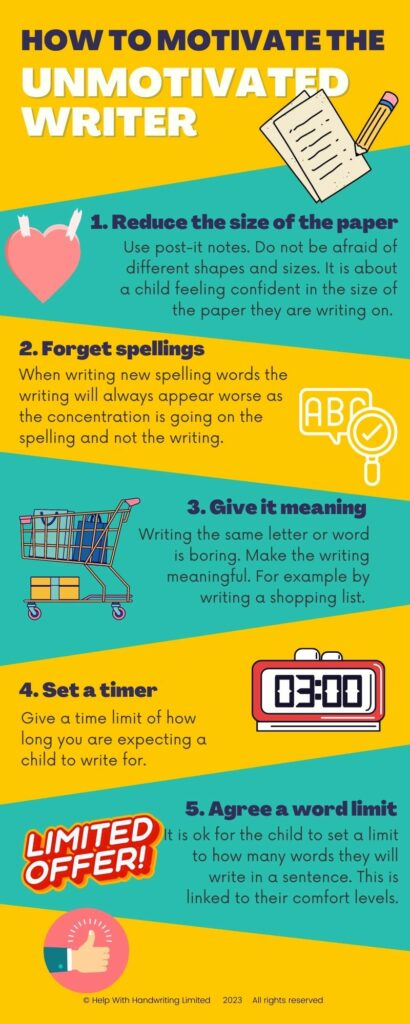Is it possible to motivate handwriting?
Have you ever tried to motivate handwriting? To encourage someone to write who REALLY does not want to is difficult. In reality, it is nion impossible. If you come across someone who is not keen on writing there are a few stealth tactics that you can try. Yet the reality is that most children will see your cunning plan before you think they have ever noticed it.
Motivation happens when we understand why we are doing something.
Without this meaning, handwriting can seem pointless. The difficulty these days is trying to explain that handwriting is not ‘old hat’. Schools are now providing more opportunities for children to type their work. This can be counterproductive and does not help when trying to explain the reason why we need to write. Unfortunately, saying we have to, or it’s something that we must do to pass exams it’s not helpful.
Here are a few reasons on why handwriting is a crucial life skill:
- Handwriting helps engage both sides of the brain. The right side is the more creative side. This helps to create ideas for stories, poems and plays. The left side of the brain is the more logical side. It helps us make sense of what we are writing. We use both two sides when we are writing.
- If we have a difficult problem in our lives, sometimes it can be helpful to write our thoughts down on paper. This can help us make sense of what is happening and how we are feeling. Giving yourself the time and space to write, can help give you that thinking time needed to create a plan of action.
- Handwriting can help clarify an idea. Sometimes you need to write down all your thoughts to review them. Doing this can help you write in a concise manner.
- Writing things down can help you to keep things in your memory, and this is really crucial. This is the one reason I always use to motivate handwriting when helping a child understand why we write. Research shows us that those who write their answers are more successful learners. They are able to retain their information for longer than those who type their work. In the long run, they are saving themselves time because they can remember what they have learnt. Rather than having to revise for even longer to keep it in their memory banks.
- There are many jobs that need handwriting. Yes, we may not handwrite reports but how many times in the day with your work do you write something? Even my plasterer was writing the alphabet on the pieces of covering he had cut to make sure they all matched up.
Here are a few stealth tactics to help motivate handwriting for a reluctant writer:

1. Reduce the size of the paper.
Many children get overwhelmed when they have a large A4 piece of paper to write on. For them, they see a large, blank piece of paper. They become concerned that they are being asked to write on the whole page. Try using smaller pieces of paper or even writing on Post-It notes. (Nowadays you can get Post-It notes with lines on. I would highly recommend using them!)
Writing on smaller pieces of paper gives a child boundaries that they understand. They know they are never going to write more than the size of the paper. This can help them to relax when writing. Obviously, you could always ask them to write on a second piece of Post-it note paper.
2. Do not try and combine spellings with handwriting.
Learning new spellings use higher cognitive thinking skills. Asking a child to remember the word and how to write can be tricky. I would always expect handwriting to deteriorate when writing new spellings.
3. Add meaning to the writing.
Asking a child to do a worksheet where letters are repeatedly written. Does not add meaning to the handwriting. It would be better to ask a child to address an envelope over. Or write a shopping list for you. This way they can understand how they’re writing is being used and why it needs to be readable.
4. Set a time limit.
When children know that they have a set amount of time they will do the writing for the agreed time. Firstly, start with a few minutes and then gradually increase the length of time over a number of days/weeks. Some children like to see a countdown clock when they’re writing. They like to know that they are not being tricked into writing longer than the time they said they would do.
5. Do not be afraid to agree on the number of words written in a sentence.
Having a three worded sentence is better than having someone who is not willing to try to write. Once a three worded sentence has been written we may try and push it to four words next time. But it must remain within the child’s comfort zones. When they are ready to write more they will do this with no negotiation on the word limit.
The unmotivated writer worries about their work is not good enough. Let’s help them to become confident and motivated to express their thoughts/ideas.
We will always see those who improve their handwriting but remain reluctant to write. Not every child enjoys writing. As long as the writer has a good reason to do it we should not be having struggles to motivate handwriting. If you are interested in your child taking lessons with us, take a look here > handwriting lessons.

P.S. Our top tip about reducing the paper size features in Twinkl’s 9 Tips to Inspire Reluctant Writers to Write for encouraging children to develop their handwriting skills.









